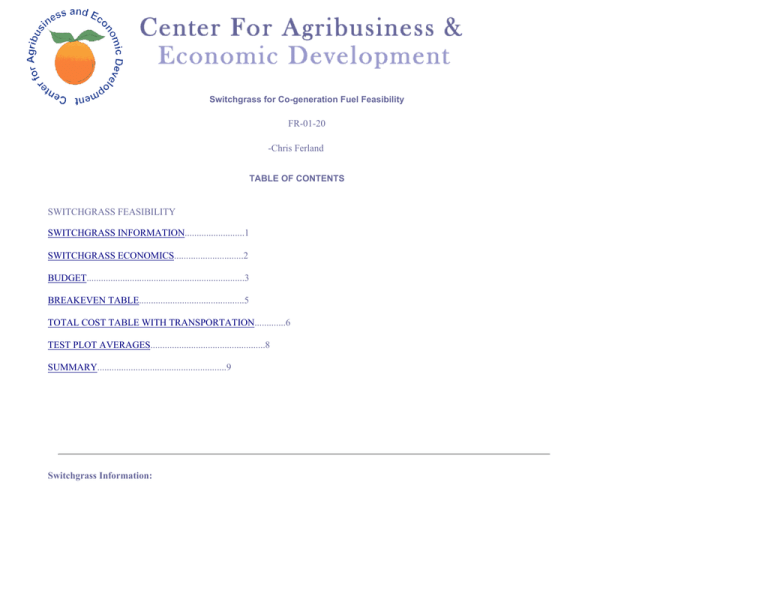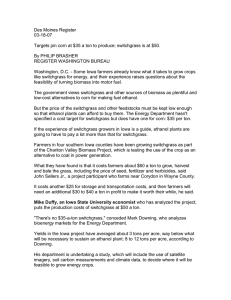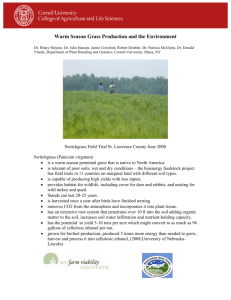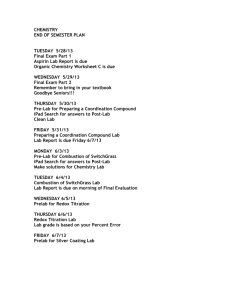FR-01-20 -Chris Ferland SWITCHGRASS FEASIBILITY
advertisement

Switchgrass for Co-generation Fuel Feasibility
FR-01-20
-Chris Ferland
TABLE OF CONTENTS
SWITCHGRASS FEASIBILITY
SWITCHGRASS INFORMATION.........................1
SWITCHGRASS ECONOMICS.............................2
BUDGET..................................................................3
BREAKEVEN TABLE............................................5
TOTAL COST TABLE WITH TRANSPORTATION.............6
TEST PLOT AVERAGES................................................8
SUMMARY......................................................9
Switchgrass Information:
Switchgrass (Panicum virgatum L.) is a native grass species to much of the USA. It has recently shown great potential for use in
production of fuel ethanol from cellulosic biomass (Lynd et al., 1991). Work in Alabama demonstrated very high dry matter yields
can be achieved with Switchgrass (Maposse, et al., 1995) in the Southeastern USA. Therefore, this region is thought to be an
excellent choice for development of a Switchgrass cropping system where farmers can produce the grass for either biomass or
forage. Another report has shown success with selection and breeding to develop high yielding germplasm from adapted varieties
and ecotypes of Switchgrass (Moser and Vogel, 1995). At present, however, there is little plant breeding effort within the southeast
region. In this proposal, we plan to initiate a breeding program whose goal is development of high yielding, adapted varieties for use
in the Southeastern USA. We will also conduct a multi-location testing program for Switchgrass, compare its biomass production to
other adapted warm-season grass species such as bermudagrass (Cynodon dactylon L.), bahiagrass (Paspalum notatum Flugge.), and
elephantgrass (Pennisetum purpureum Schumach.), and initiate studies on some best management practices for growing the crop for
biomass, forage, and seed production.
Except for the far western states, Switchgrass occurs naturally throughout the contiguous USA (Moser and Vogel, 1995). Although
possessing rhizomes, Switchgrass is an upright growing species capable of producing high dry matter yields. Traditionally,
Switchgrass is used as a forage and conservation crop. Recently, its use in biofuel production of ethanol has been proposed (Lynd et
al. 1991). When combining its uses of forage, conservation, and biofuel production, farming systems based on Switchgrass could
become an economic boon for farmers interested in sustainable and profitable farming enterprises.
Switchgrass varieties and ecotypes are classified as either lowland or upland types (Moser and Vogel, 1995). Lowland types occur in
river bottom areas, are tall and robust, possess a bunch-type growth habit, and are tetraploids (2n=36). Upland types are shorter and
finer, possess long rhizomes which allow them to spread more, and are either hexaploids or octoploids (2n=54, 72).
In a six year study in Alabama, the lowland variety Alamo was found to average 24.5 Mg ha-1 dry matter yield (Maposse et al.,
1995) This was 42% more dry matter than another lowland type, Kanlow, but also 135% higher than the average of the six upland
varieties in the trial ('Blackwell', 'Cave-in-Rock', Kansas Native, 'Pathfinder', 'Summer', and 'Trailblazer'). This amount of dry matter
production would be considered much higher than that which could be achieved with other warm-season grasses used in the
Southeastern USA.
Although a very high yielding plant once established, Switchgrass stands planted from seed are usually very weak and early
management practices of weed and insect control are a must to insure early producing swards (Moser and Vogel, 1995). Therefore, a
great deal of research has centered on the best management systems for initially establishing and managing stands of Switchgrass.
Switchgrass Economics
Using inputs advised by the Crop and Soil Sciences department at the University of Georgia an enterprise budget was constructed for
Switchgrass production. The University has three test plots growing Switchgrass and have tested the best possible combinations of
methods and ingredients to receive the best yields. These results allow the budget to be realistic.
The variable cost associated with growing Switchgrass amounted to approximately $260 per acre. The fixed cost, including
machinery cost for the enterprise, amounted to $82 per acre. Adding a return to management at 5% of the variable cost and the preharvest interest of the same amount, the total cost per acre is $395. (Refer to budget in appendix)
The test plot yielded from 2 to 8 tons per acre, so for this study an average yield of 6 tons per acre was chosen. The breakeven price
needed for various tons appears in the chart below
Tons Per
Acre
2
3
4
5
6
7
8
9
10
Total Variable
CostPer Acre
Total Fixed
CostPer Acre
Total CostPer Acre
$131.00
$87.33
$65.50
$52.40
$43.67
$37.43
$32.75
$29.11
$26.20
$66.50
$44.33
$33.25
$26.60
$22.17
$19.00
$16.63
$14.78
$13.30
$197.50
$131.67
$98.75
$79.00
$65.83
$56.43
$49.38
$43.89
$39.50
Price PerGallon toCoverSwitchgrass
CostAlone Per Acre
$2.47
$1.65
$1.23
$0.99
$0.82
$0.71
$0.62
$0.55
$0.49
This table indicates that even with 10 tons per acre the total cost for the farmer to grow Switchgrass is around $40 per ton. The average tons per acre based off all
known test plots were 6 tons. Given this, the farmers will need to earn $66 per ton to cover the costs.
Each ton of Switchgrass is assumed to produce 80 gallons of ethanol. Using the above cost for growing Switchgrass, one can establish the ethanol price
necessary to cover the cost of Switchgrass as an input. When an acre yields 6 tons of Switchgrass, the minimum price of ethanol to cover Switchgrass is $.82.
This chart simply shows that to cover the Switchgrass cost the ethanol price per gallon has to be at the above price. This does not include any of the other costs
needed in producing ethanol.
One problem with Switchgrass is the transportation and shrinkage factor. Presently little testing has been done on what the actually shrink amount in the grass
may be. Researchers suggest anywhere from 10% to 40% basing this off forage shrinkage rates. So, when the shrink factor and transportation are added to the
equation for the average yield of 6 tons at 30% shrinkage the breakeven become $81.25. (Refer to chart in appendix)
University of Georgia Research Programs:
The University of Georgia has for many years conducted, especially in conjunction with the USDA, a forage grass and legume breeding project for the Southeast
and has released several commercially successful varieties during that time. The strengths of these breeding efforts are 1) scientists and technical staff
experienced in development, release, and dissemination of new grass and legume varieties, 2) availability of a network of branch stations which allows selection
and testing of germplasms over a range of climates and soil physiographic regions, 3) access to animals during selection and testing to insure collection of
information on pasture dependability and livestock performance, and 4) a region where "native" Switchgrass ecotypes can be collected.
Switchgrass (based off Dr. Joe Bouton and Dr. Carl Hoveland)
Prepared by John C. McKissick, Bill Givan and Chris Ferland
Ext. Ag. Econ. Dept., Univ. of Ga.
2001
Switchgrass
(Total Cost Budget)
NUMBER OF ACRES
BEST
YIELD (TONS)
SELLING PRICE ($/TON)
9.00
90.00
1.00
OPT.
MEDIAN
8.00
80.00
6.00
60.00
PESS. WORST
4.00
40.00
2.00
20.00
ITEM
UNITS
TOTAL
UNIT
TOTAL
PER ACRE
QUANTITY
PRICE
AMOUNT
(units)
($/unit)
($)
UNIT
VARIABLE COSTS:
LIME
TON
0.50
1
24.00
12
NITROGEN
LB.
200.00
200
0.24
48
PHOSPHATE
LB.
60.00
60
0.25
15
POTASH
LB
125.00
125
0.13
16
HERBICIDES
ACRE
1.00
1
7.00
7
FUEL
GAL
13.00
13
0.85
11
REPAIRS & MAINT.
ACRE
1.00
1
32.00
32
TWINE
BALE
0.13
0
20.00
3
LAND RENTAL
ACRE
1.00
1
20.00
20
LABOR
HRS
10.00
10
8.00
80
OTHER
$
0.00
0
0.00
0
INTEREST ON OP. CAP.
$
241
9%
22
FERTILIZER:
MACHINERY
TOTAL VARIABLE COST
263
Fixed Cost:(Press Button for Annual Cost)
Direct Fixed Cost
Pre-Harvest
Management
Land
Total Fixed Cost
Acre
$
$
Acre
1
263
263
1
81.59
0.05
0.00
0.00
82
13
0
0
95
EXPECTED BREAKEVEN TABLE
TOTAL AMOUNT
263
82
13
0
0
357
ITEM
VARIABLE COST
DIRECT FIXED COST
OVERHEAD
MANAGEMENT
LAND
TOTAL COST
$ / TON
44.06
13.69
2.20
0.00
0.00
59.95
$/Acre
262.58
81.59
13.13
0.00
0.00
357.30
EXPECTED RETURN TABLE
1 ACRE
EXP. YIELD
(Tons/Acre)
5.96
TOTAL YIELD
(tons)
5.96
EXP. PRICE
($/ton)
59.60
TOTAL RETURN
($)
355
RISK RATED RETURNS OVER TOTAL COST
Net return levels (TOP ROW);
The chances of obtaining this level or more (MIDDLE ROW); and
The chances of obtaining this level or less (BOTTOM ROW).
Optimistic
Returns($)
Chances
Chances
214
6%
CHANCE FOR PROFIT
138
16%
47%
Expected
61 -15
32% 51%
49%
Pessimistic
-97
-179
-260
30%
16%
7%
BASE BUDGETED NET REVENUE
-10
Total Cost with
Transportation
Ton Per Acre
2
3
4
5
6
7
8
9
10
5%
$190.58
$128.10
$96.86
$78.12
$65.63
$56.70
$50.01
$44.80
$40.64
10%
$199.65
$134.20
$101.48
$81.84
$68.75
$59.40
$52.39
$46.93
$42.57
Percent Shrink
15%
$208.73
$140.30
$85.56
$85.56
$71.88
$62.10
$54.77
$49.07
$44.51
20%
$217.80
$146.40
$110.70
$89.28
$75.00
$64.80
$57.15
$51.20
$46.44
25%
$226.88
$152.50
$115.31
$93.00
$78.13
$67.50
$59.53
$53.33
$48.38
30%
$235.95
$158.60
$119.93
$96.72
$81.25
$70.20
$61.91
$55.47
$50.31
35%
$245.03
$164.70
$124.54
$100.44
$84.38
$72.90
$64.29
$57.60
$52.25
40%
$254.10
$170.80
$129.15
$104.16
$87.50
$75.60
$66.68
$59.73
$54.18
Summary
Georgia can compete in Switchgrass production based on yield alone, but the inputs used to achieve these results are higher than other locations. Iowa?s Switchgrass
grows wild on Conservation Reserve Program land and yields range from 2 to 6 tons per acre. Their land was already in the CRP prior to any establishment of
Switchgrass use as a co-generation fuel.
The Sheraton Valley RCD created the Switchgrass program in conjunction with the Farm Service Agency (FSA). Each state?s CRP can differ depending on FSA and
state officials.
The harvesting of Iowa?s Switchgrass occurs by the electric companies. Using adapted John Deere forage harvest equipment. Harvesting cannot occur within 100 feet
of water. A reduction of 25% in CRP payments occurs with any income made off the land. Iowa?s program is still in the pilot stage and nothing has been finalized.
Even though Switchgrass is an interesting idea, for Georgia to contemplate the growing and use of Switchgrass a higher return to farmers needs to occur. Breakevens
place Switchgrass in the similar category as high-value forage crops.


